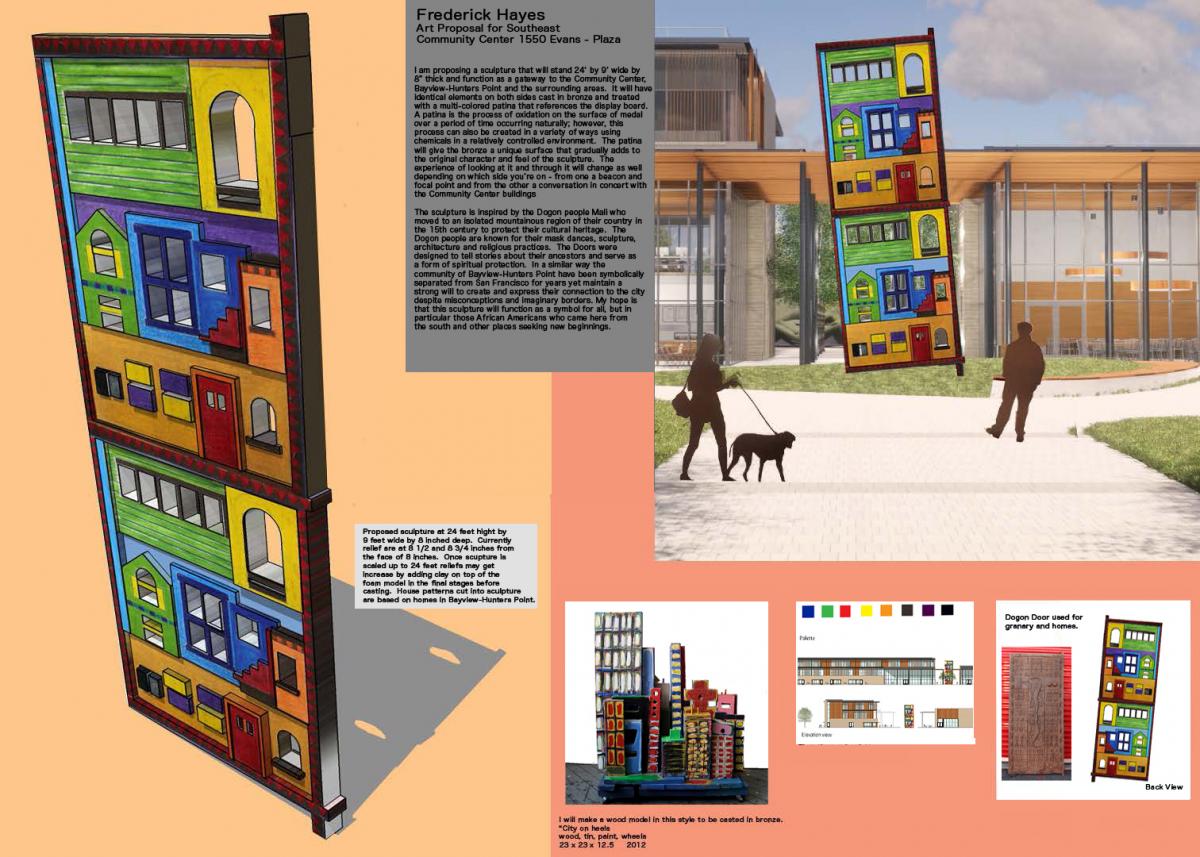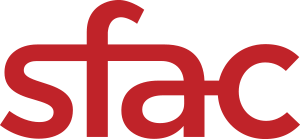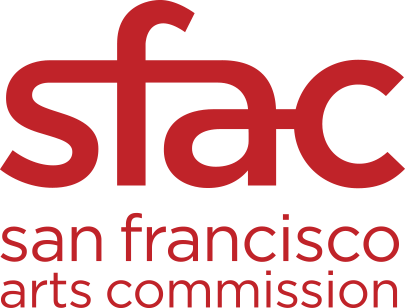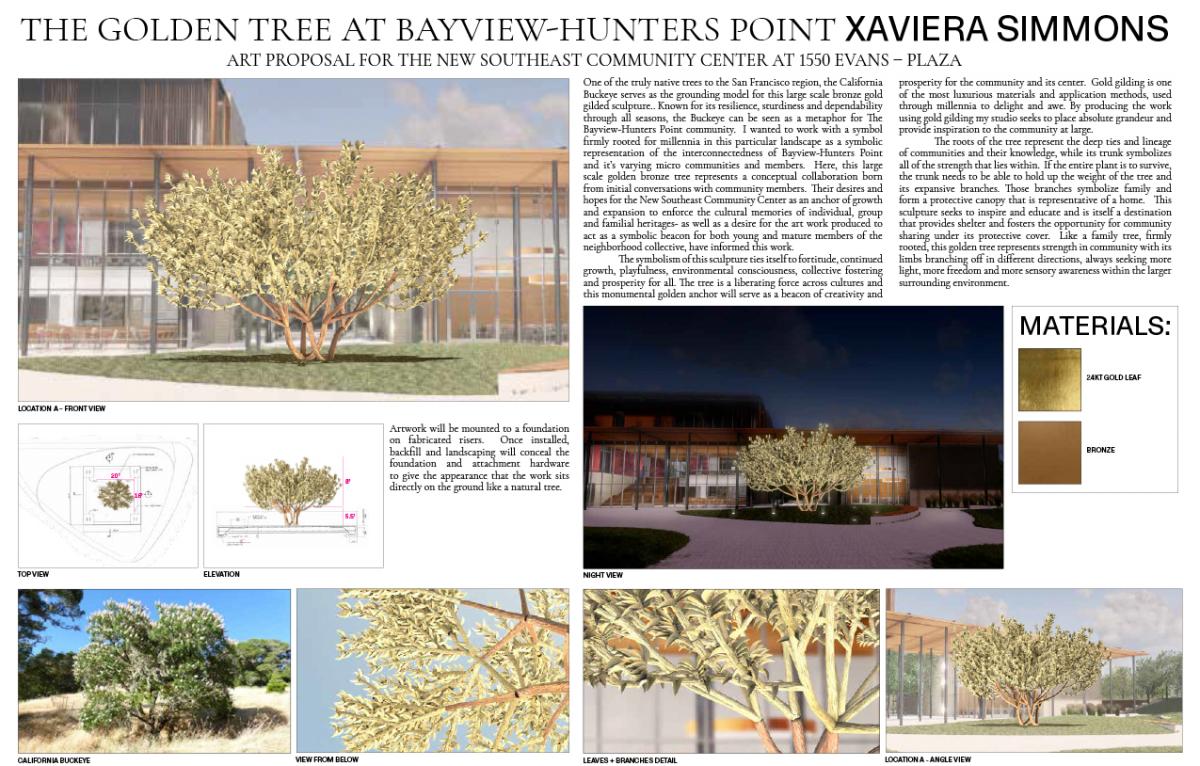
I propose to create a 24 ft x 9 ft x 8-inch bronze sculpture the commemorates the notion of Bayview-Hunters Point community as home and a place that welcomes all while acknowledging the rich history of the African American community. Using the motif of the Dogon Door, I have designed a multi-colored door depicting relief elements based on facades of homes in the Hunters Point-Bayview area with the window sections of those facades cutout to draw the viewer into the work while simultaneously glimpsing into what’s beyond. The sculpture is actually composed of one section that repeats 4 times two on the front and two on the back, but because of the variety of holes and shapes when facing it coming to the center or leaving your response will never be the same as the eye takes into account the various relationship and points of view. This notion of repetition is central to all art making and African design in particular. The colors will be red, yellow, blue, green, brown, purple, green and done in a patina that closely matches the original concept but not overly bright. All areas will be accessible for maintenance which only require a simple washing and re-waxing to prevent oxidation of the metal.
Process:
Working with the Artworks Foundry in Berkeley, I will create a 6-foot-tall model out of wood to be shipped to their Foundry from New York for enlargement, welding and armature design for the structure. This process consists of scanning the 6 model which will be scaled up to appropriate size using a urethane foam, afterwards a thin layer of clay will be placed on top of the foam. I will then go to the Foundry to shape the clay surface and make necessary corrections and/or enhancements for final casting. After casting, the sculpture will then be assembled and shipped to the site or storage prior to installation.
Artist Role:
Design and assemble a 6 feet by 4.5 feet x 4-inch model of the sculpture to be shipped to Berkeley for production to scale of proposed sculpture. The model will be made of construction lumber, plywood, and found wood, if appropriate. After the original model has been scaled up to 12 x 9 feet x 8 inches on foam I will then travel to California to shape and refine the sculpture using a thin layer of clay provided by Artworks Foundry before the casting. My role will also consist of training and supervising interns for my
Mapping Bayview-Hunters Point Community Engagement Project for a period of 10 weeks with periodic visits.
Mapping Historic Homes in Bayview-Hunters Point (Community Art Engagement):
If selected for the commission at the Southeast Community Center I propose a community mapping project based on the surrounding areas of the current and future home of the Community Center using the historic housing listed in the Bayview Hunters Point Area B Survey date 2010 as a starting point. This document shows houses in relative proximity to the Community Center, and goes on to define what makes them historic and why, such as design and year built. What’s missing from this survey is the resident, the neighbor, and object or artifact that tell their story or give more insights into the community and neighborhood. At minimum, I think that each street tells a story, has a unique charm and character, and has a lot to say.
With the help of community leaders, teens, the Southeast Community Center and some of the tenants the occupy the Center, my goal is to conduct a series of mapping projects over the course of 12 weeks in the summer of 2020 and summer of 2021. Using the addresses and images in the Area B Survey students will re-photograph those houses and locations while looking for others that define the neighborhood and street to form a bigger picture that speaks about location, community, place, and people. Students will be accompanied by interns, and may also ask residents of the street if they would be willing to answer a series of questions as a way of drawing clearer distinctions between neighborhoods:
How long have you lived here? How does blank_______ differ from where you live and what do they have in common? What are some of the unspoken rules that makes each place unique? If you had a choice would you live someplace else? How would you define your role in the community? Do you live here, but your real community is somewhere else? Do you know anything about the houses on the street? Any tall tales or short ones?
This project empowers teens by instilling confidence in them, and giving them the opportunity to learn about their community from older residents, as well. Because this project will also focus on architecture, they will have the opportunity to learn about the different types housing in the area and, in some cases, why they exist. I presently have identified the Bayview Historical Society as a possible website that might be willing to host this project. Other places might be Found SF (bayview-hunterspoint.org /history) and SPUR. Initially, though it could just begin with a Facebook page as an early way of tracking the kids progress. Also, there are several youth organizations in the Bayview Hunters Point that I could partner with for this project.
Frederick Hayes
位於1550 Evans的東南社區中心
廣場雕塑提案說明
Frederick Hayes
Centro Comunitario del Sureste en 1550 Evans
Descripción de la propuesta de escultura para la explanada
Frederick Hayes
Southeast Community Center sa 1550 Evans
Salaysay ng Panukala sa Iskultura sa Plasa
View a large image of the proposal.




 I propose to create a 24 ft x 9 ft x 8-inch bronze sculpture the commemorates the notion of Bayview-Hunters Point community as home and a place that welcomes all while acknowledging the rich history of the African American community. Using the motif of the Dogon Door, I have designed a multi-colored door depicting relief elements based on facades of homes in the Hunters Point-Bayview area with the window sections of those facades cutout to draw the viewer into the work while simultaneously glimpsing into what’s beyond. The sculpture is actually composed of one section that repeats 4 times two on the front and two on the back, but because of the variety of holes and shapes when facing it coming to the center or leaving your response will never be the same as the eye takes into account the various relationship and points of view. This notion of repetition is central to all art making and African design in particular. The colors will be red, yellow, blue, green, brown, purple, green and done in a patina that closely matches the original concept but not overly bright. All areas will be accessible for maintenance which only require a simple washing and re-waxing to prevent oxidation of the metal.
I propose to create a 24 ft x 9 ft x 8-inch bronze sculpture the commemorates the notion of Bayview-Hunters Point community as home and a place that welcomes all while acknowledging the rich history of the African American community. Using the motif of the Dogon Door, I have designed a multi-colored door depicting relief elements based on facades of homes in the Hunters Point-Bayview area with the window sections of those facades cutout to draw the viewer into the work while simultaneously glimpsing into what’s beyond. The sculpture is actually composed of one section that repeats 4 times two on the front and two on the back, but because of the variety of holes and shapes when facing it coming to the center or leaving your response will never be the same as the eye takes into account the various relationship and points of view. This notion of repetition is central to all art making and African design in particular. The colors will be red, yellow, blue, green, brown, purple, green and done in a patina that closely matches the original concept but not overly bright. All areas will be accessible for maintenance which only require a simple washing and re-waxing to prevent oxidation of the metal. West African metal sculpture in copper, bronze and iron stands at the intersection of art, jewelry and wealth: in addition to being used as a currency for exchange, such objects could be worn as a sign of success, embodying one’s power. Currency is worn in many cultures around the world, with each piece representing both a symbolic and an economic value. My proposal takes its inspiration from this powerful signifier, using forms drawn directly from traditional Ivory Coast currency to memorialize the unsung contributions of the African-American community in the Bayview-Hunter’s Point neighborhood – a community that has been displaced and troubled due to gentrification and the rise of a new, digitally-oriented economy. Like the people of Bayview-Hunter’s Point, these emblems of African currency are precious jewels and repositories of intangible wealth.
West African metal sculpture in copper, bronze and iron stands at the intersection of art, jewelry and wealth: in addition to being used as a currency for exchange, such objects could be worn as a sign of success, embodying one’s power. Currency is worn in many cultures around the world, with each piece representing both a symbolic and an economic value. My proposal takes its inspiration from this powerful signifier, using forms drawn directly from traditional Ivory Coast currency to memorialize the unsung contributions of the African-American community in the Bayview-Hunter’s Point neighborhood – a community that has been displaced and troubled due to gentrification and the rise of a new, digitally-oriented economy. Like the people of Bayview-Hunter’s Point, these emblems of African currency are precious jewels and repositories of intangible wealth. WE ARE THE FUTURE’S ANCESTORS is designed to connect our past and our present with the future of the Bayview Community.
WE ARE THE FUTURE’S ANCESTORS is designed to connect our past and our present with the future of the Bayview Community. One of the truly native trees to the San Francisco region, the California Buckeye serves as the grounding model for this large scale bronze, gold gilded sculpture. Known for its resilience, sturdiness and dependability through all seasons, the Buckeye can be seen as a metaphor for The Bayview-Hunters Point community. I wanted to work with a symbol firmly rooted for millennia in this particular landscape
One of the truly native trees to the San Francisco region, the California Buckeye serves as the grounding model for this large scale bronze, gold gilded sculpture. Known for its resilience, sturdiness and dependability through all seasons, the Buckeye can be seen as a metaphor for The Bayview-Hunters Point community. I wanted to work with a symbol firmly rooted for millennia in this particular landscape
Opportunity For Public Comment
Please take a few minutes to review the proposals above here and complete a comment form below. You may also email your comments to sfacpublicartcomment@sfgov.org, or hand deliver/mail comments to 401 Van Ness Avenue, Room 325 by December 20, 2019, 5 p.m.
The Final Artist Review Panel meeting will take place on Tuesday, January 7, 2020 1:00 p.m – 5:00 p.m. at 401 Van Ness Avenue, Room 302. All Artist Review Panel meetings are open to the public. An agenda for the meeting will be posted 72-hour in advance of the meeting on SFAC’s website under the Public Meeting section: www.sfartscommission.org/calendar